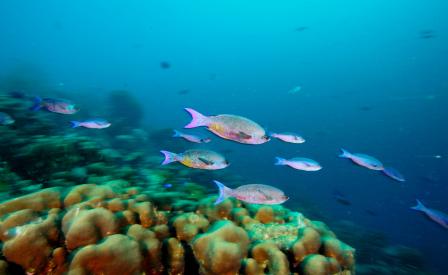What EPA is Doing to Protect Coral Reefs
 Creole wrasse and Orbicella annularis, a species of stony coral. Photo credit: Charles LoBue/EPA.Executive Order 13089, Coral Reef Protection (PDF)(3 pp, 173 K, About PDF) calls for all federal agencies whose activities may affect coral reef ecosystems to:
Creole wrasse and Orbicella annularis, a species of stony coral. Photo credit: Charles LoBue/EPA.Executive Order 13089, Coral Reef Protection (PDF)(3 pp, 173 K, About PDF) calls for all federal agencies whose activities may affect coral reef ecosystems to:- identify such actions;
- use their programs and authorities to protect and enhance coral reef ecosystems; and
- ensure that any actions they authorize, fund, or carry out will not degrade the condition of coral reef ecosystems.
EPA protects coral reefs by implementing Clean Water Act programs that protect water quality in watersheds and coastal zones of coral reef areas. EPA also supports efforts to monitor and assess the condition of U.S. coral reefs, and conducts research into the causes of coral reef deterioration. EPA is developing tools to help adapt coral reefs to better handle changing conditions. Much of EPA’s work to protect coral reefs is conducted in partnership with other federal agencies, states, and territories. For example, EPA is an active member of the interagency U.S. Coral Reef Task Force.
Clean Water Act and Coral Reefs
EPA strategically applies its Clean Water Act (CWA) regulatory and non-regulatory programs to reduce land-based sources of pollution that degrade coastal waters and coral reefs that live in them. Improving coral reef health by addressing local stressors will enhance their natural resilience. EPA:
- Provides funding and technical assistance to state and territory coral monitoring and assessment programs (CWA 106).
- Targets nonpoint source (CWA 319) funds to implement water quality improvement projects in watersheds that discharge into coral reef locations.
- Works with states to improve the environmental protections provided by National Pollutant Discharge Elimination System sewer and stormwater management permits (CWA 402).
- Works with the U.S. Army Corps of Engineers to avoid and minimize impacts to coral reefs from discharges of dredged or fill material avoid and minimize impacts to coral reefs, and to provide compensatory mitigation for unavoidable impacts (CWA 404; see also Coral Reef Guidance: 1999 Memorandum to the Field).
- Supports derivation and adoption (by states) of water quality standards to increase protection of corals. Under the Endangered Species Act (ESA), EPA consults with NOAA to ensure that new/revised criteria are fully protective of ESA-listed coral species and their critical habitats.
- Supports the development of biological assessment methods and biological criteria for states, tribes, and territories to use in evaluating the health of coral reefs and associated water quality.
- Works to reduce trash from entering coastal waters through EPA’s Trash-Free Waters program.
- Ensures that dredging and ocean disposal of dredged material is conducted in a manner that does not adversely impact coral reefs (CWA 403 criteria).
- Works with the Coast Guard to regulate the transportation of municipal and commercial waste on vessels and to issue regulations for the manufacture, maintenance, and efficiency of marine sanitation devices (boat toilets), as well as the establishment of “no discharge zones” for vessel sewage (CWA 312).
U.S. Coral Reef Task Force
EPA is actively engaged in the U.S. Coral Reef Task Force (USCRTF). The USCRTF was established by Executive Order 13089 to lead U.S. efforts to preserve and protect coral reef ecosystems. It is instrumental in building partnerships and strategies for on-the-ground action to conserve coral reefs. The USCRTF is co-chaired by the National Oceanic and Atmospheric Administration and the Department of the Interior with regular participation from twelve federal agencies, seven states and territories, and three freely associated states.
EPA chairs and participates on several USCRTF working groups, including the Climate Change and Ocean Acidification Working Group, Enforcement Working Group, and the Watershed Partnership Initiative Working Group. Recent products of these working groups that EPA helped to develop include:
Corals and Climate Adaptation Planning (CCAP) Adaptation Design Tool and User’s Guide
The Corals and Climate Adaptation Design Tool can be used by coral reef managers to incorporate climate-smart design into their programs and projects at any stage of planning and implementation. The tool has been used with partners in Guánica Bay, Puerto Rico and West Maui, Hawai'i.
Handbook on Coral Reef Impacts: Avoidance, Minimization, Compensatory Mitigation, and Restoration
This Handbook on Coral Reef Impacts provides a review of the federal authorities, existing policies, and federal, state, and territory roles and responsibilities; a compendium of current best practices—science-based methodologies for quantifying ecosystem functions or services; and a general overview of basic protocols available for use when assessing impacts to coral reef ecosystems and mitigating or restoring for unavoidable impacts to coral reef ecosystems, including the use of appropriate compensatory action to replace the lost functions and services.
USCRTF Watershed Partnership Initiative Priority Ecosystem Indicators
The USCRTF Watershed Partnership Initiative Priority Ecosystem Indicators document (PDF)(56 pp, 1.5 MB, About PDF)provides coastal managers, coral reef managers, and watershed coordinators faced with modest budgets a suite of recommended ecological indicators and measurements to include in their watershed-specific monitoring plans. The recommended ecological indicators and measurements help determine the efficacy and evaluate the success of management efforts to reduce land-based sources of pollution on coral reef ecosystems.
USCRTF Watershed Partnership Initiative Programmatic Checklist
A user-friendly programmatic checklist (PDF)(6 pp, 575 K, About PDF)developed to help managers and watershed coordinators identify programmatic needs for the successful implementation of a ridge to reef watershed management plan.
International Coral Reef Initiative
The U.S. Federal Government is a member of the International Coral Reef Initiative (ICRI),Exita partnership between Nations and organizations which strives to preserve coral reefs and related ecosystems around the world. ICRI has declared 2018 as the third International Year of the Reef (IYOR).ExitIYOR is a global effort to build awareness and understanding of coral reef ecosystems to support conservation, research, and management.
